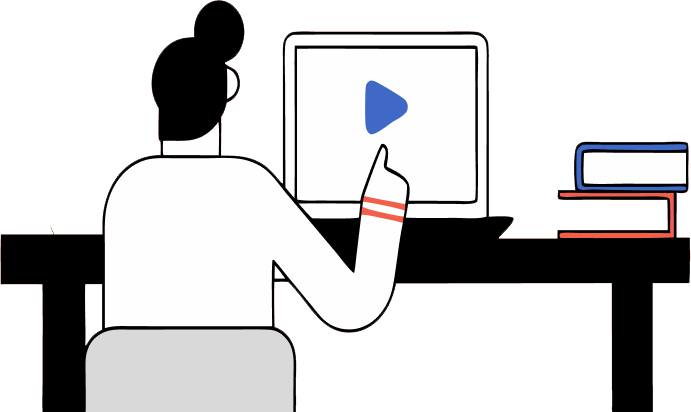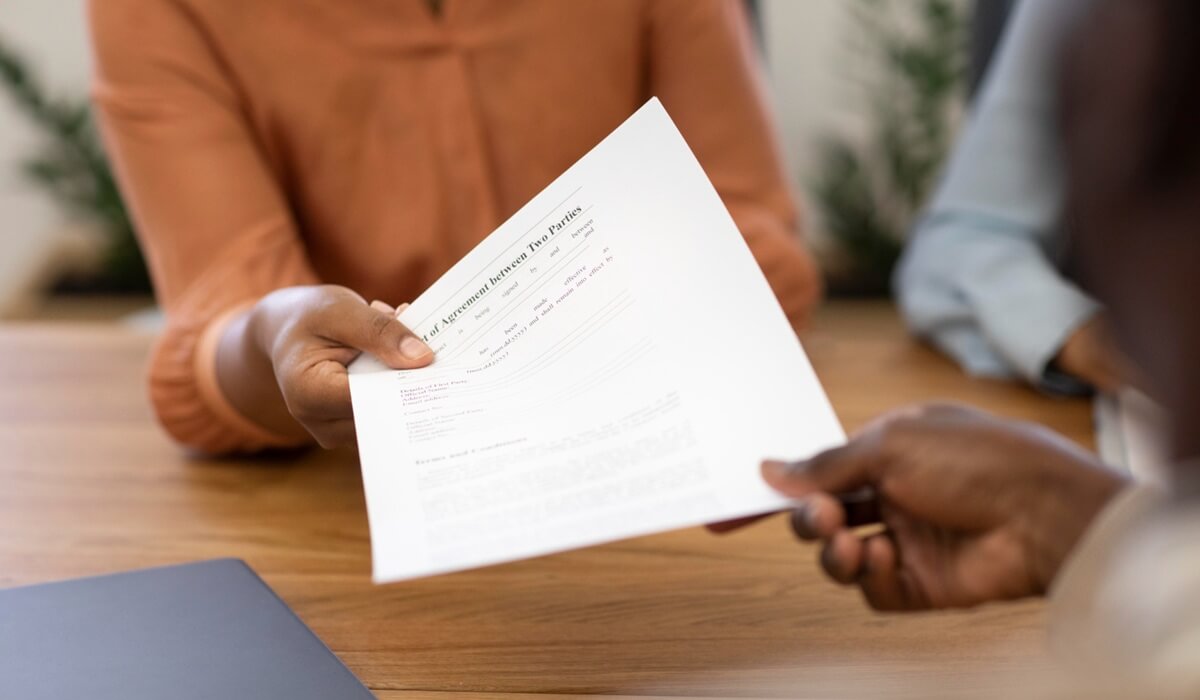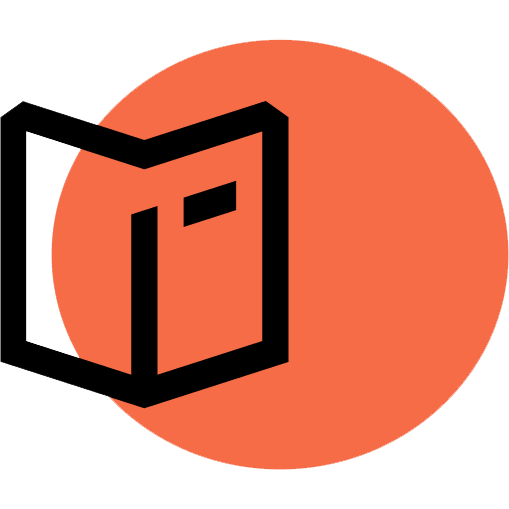Table of Contents

So, you want to work in the US? Awesome! But wait, what’s this H-1B visa everyone keeps talking about? Is it a magical golden ticket? Kind of… but with more paperwork and fewer songs.
Every year, thousands of smart, skilled people dream of building a career in the US. The H-1B visa helps make that dream possible, but only if you understand how it works. There are rules. Deadlines. Lotteries. Government forms with names like “I-129”. Don’t worry; Visa Library will guide you through every step of the H-1B journey.
What Is the H-1B Visa?
The H-1B visa is a special work visa that lets US companies hire skilled workers from other countries for jobs that need a college degree or special training. These jobs are in fields like:
- Technology (like software or IT)
- Engineering
- Science and math
- Healthcare
- Business and more
It’s a great option for international students who want to stay and work in the US after graduation. Many use it to start their careers here.
Key Points About the H-1B Visa
- This is a non-immigrant US work visa.
- You must have a job offer from a US employer.
- Your job must need specialized skills and usually a bachelor’s degree or higher.
- The H-1B visa validity is 3 years and can be extended up to 6 years.
- There’s a limited number of visas each year (65,000 + 20,000 for U.S. Master’s holders).
- The H-1B visa lottery system is used when applications exceed the cap.
- The visa allows you to apply for a green card while on H-1B.
- The process includes Labor Condition Application (LCA) and USCIS petition filing.
H1B Visa News and Updates 2025
There have been some important updates to the H-1B visa process in 2024 and 2025:
- USCIS is speeding up H-1B applications for US college graduates, including DACA recipients, with high-skilled job offers.
- There’s a stronger focus on applicants who earned degrees in the US, even outside of traditional STEM fields.
- DACA recipients now have a clearer path to apply for H-1B visas, with better support and potential routes to permanent residency.
- US consular officers now have clearer guidance to recommend waivers of ineligibility, helping more qualified applicants move forward.
- As of 2025, H-1B visa interviews at most US embassies abroad have minimal wait times, making the process faster for international applicants.
H-1B Visa Requirements for Employers and Workers
To get an H-1B visa, both the US employer and the foreign worker must meet certain rules to make sure the application is valid and successful.
For the Employer
If you are among the companies that sponsor H1B visas, you must:
- Prove it’s a “Specialty Occupation.” The job must need someone with deep, specialized knowledge, usually a bachelor’s degree or higher in a specific field like tech, engineering, medicine, science, or finance.
- Pay the “prevailing wage” (the standard pay for similar jobs in your area), or at least what you pay others doing the same job.
- File a Labor Condition Application (LCA) before filing the H-1B petition with the Department of Labor. In LCA, you must promise to pay fair wages, to provide good working conditions, that there’s no strike or layoff in that job category, and that hiring this worker won’t hurt US workers.
- Submit the H-1B petition (Form I-129 with USCIS) if your candidate gets selected in the H-1B lottery (if subject to the cap).
- Have a real employer-employee relationship, meaning you must be able to hire, pay, manage, and fire the worker.
For the Employee
If you’re the worker applying for an H-1B visa, you’ll need to meet these key requirements:
- You must have at least a bachelor’s degree (or equivalent) in a field related to the job. If your degree is from outside the US, you may need an official evaluation to prove it’s equivalent.
- You must be able to show that you have expertise in the area the job requires. Sometimes, work experience can count—3 years of experience may equal 1 year of college.
- You need a real job offer in a qualifying field, such as software/IT, engineering, accounting or finance, healthcare, education, architecture, law, science, marketing, and more.
Extra Things to Know
- Some jobs (like at universities or research institutions) don’t go through the annual H-1B visa lottery. These are cap-exempt, and you can apply any time of year.
- If you’re already in the US, make sure you’re following all immigration rules. Keep your documents updated and notify USCIS if anything about your job changes.
- Some jobs, like doctors, nurses, or lawyers, require a license to work in the US. You usually need to have this license before your visa can be approved.
H-1B Visa Benefits
For Employers:
- You can hire talented people from all over the world.
- Great way to bring in unique skills your current team might not have.
- Adds fresh ideas and new ways of thinking to your company.
- Helps fill hard-to-hire positions, especially in tech, science, and healthcare.
- Makes your business more competitive globally.
For Employees:
- You get to live and work legally in the US.
- Opens the door to top career opportunities and better salaries
- You might be able to apply for a green card later and stay long-term.
- Gain real-world experience in US companies, which looks great on your resume
- Boosts your personal and professional growth by working in a new environment
H-1B Visa Cap and Lottery System
Every year, the US government gives out a limited number of H-1B visas. Because way more people apply than there are visas available, they use a lottery system to decide who gets to move forward.
Here’s how the cap and lottery system works:
- 65,000 visas are set aside for most people, which is called the regular cap.
- 20,000 extra visas go to people with a master’s degree or higher from a US school. This gives you a better chance if you have an advanced degree.
- That means the total number of H-1B visas available each year is usually 85,000.
Even if you meet all the rules and have a great job offer, getting picked isn’t guaranteed. That’s why it’s called a lottery since it’s random.
How does the H-1B Lottery actually Work?
Your employer submits your basic info to USCIS in March. If too many people apply (which usually happens), USCIS randomly picks who can move on. Then, if you’re selected, your employer can file the full H-1B petition. If not, you can wait for the next year or try a different visa route.
Remember! If you have a US master’s degree, you get two chances in the lottery: once in the advanced degree pool and again in the regular pool if you’re not picked the first time.
Who Qualifies for the H-1B Specialty Occupations?
To get an H-1B visa, the job and the person both need to meet certain rules.
The Job Must Meet One of These Conditions:
- A bachelor’s degree (or higher) is the usual requirement for the role.
- It’s standard in the industry to ask for a degree for this kind of job.
- The employer normally requires a degree for this position.
- The job is so complex or technical that only someone with a degree can do it.
The Worker (You) Must Meet One of These Conditions:
- You have a US bachelor’s or higher degree in the same field.
- You have a foreign degree that equals a US degree.
- You hold a state license or certification (if the job requires it).
- You have a mix of education, training, and experience equal to a US degree.
Real-Life Examples of H-1B Specialty Jobs
Industry | Job Titles | What You Need |
Engineering | Software Engineer, Mechanical Engineer | Bachelor’s in Engineering |
Computer Science | Data Scientist, IT Analyst, QA Tester | Bachelor’s in CS, IT, or related field |
Healthcare | Doctor, Nurse, Surgeon, Pharmacist | Medical degree + license |
Accounting | CPA, Financial Auditor | Bachelor’s in Accounting or Finance |
Architecture | Architect, Urban Planner | Bachelor’s in Architecture |
Science | Biochemist, Environmental Scientist | Bachelor’s in related science field |
Education | University Lecturer, Academic Researcher | Usually a Master’s or Ph.D. |
Law | Legal Consultant, Foreign Law Advisor | Law degree + license (if needed) |
Marketing/Business | Marketing Manager, Business Analyst | Bachelor’s in Marketing, Business, or Econ |
How to Apply for a H-1B Visa?
Let’s talk about the H1B visa application and how to get this visa step by step:
Step 1: Job Offer and Employer Preparation
Before anything else, you need a valid job offer from a US employer for a position that qualifies as a specialty occupation:
- The US employer identifies a foreign worker (you) for a role that requires specialized skills or education.
- The job must clearly meet USCIS requirements for a “specialty occupation.” Fields like IT, engineering, finance, and healthcare are common.
- The employer must confirm they are willing to sponsor your H-1B visa, meaning they’ll handle most of the paperwork and fees on your behalf.
Step 2: H-1B Registration (Lottery Phase)
Before your employer can file a full petition, they must register you online during the official H-1B lottery window. Remember that this applies only to cap-subject H-1B applications. The process works like this:
- Your employer creates or logs into a myUSCIS account.
- During the registration period (usually in March), they submit a $215 electronic registration for each H-1B candidate.
- USCIS uses a random lottery to select from all valid registrations.
- If you’re selected, your status in the system changes to “Selected,” and your employer can then file the full H-1B petition.
Important Notes:
- Only one registration per beneficiary per employer is allowed. Duplicate submissions will get rejected.
- Each registration is tied to your passport number, and your employer must use the same information in your full petition.
Step 3: File the Labor Condition Application (LCA)
If you’re selected in the lottery, your employer must file a Labor Condition Application (LCA) with the US Department of Labor (DOL) before submitting the H1B visa full form or petition. The DOL typically certifies the LCA in about 7 business days unless issues come up. Also, your employer cannot file Form I-129 (the main H-1B petition) until the LCA is approved.
What does the LCA do?
- Confirms the job meets US wage standards.
- Protects US workers by showing that foreign workers won’t be underpaid or displaced American jobs.
Key LCA Requirements
- Your employer must agree to pay you at least the average wage for your role in the region (as determined by the DOL).
- Your employer must show that hiring you won’t harm the working conditions of US employees.
- There can’t be an active strike or lockout in the job role at the worksite.
Step 4: H-1B Petition Preparation and Filing
Once the LCA is approved, your employer is ready to complete the H-1B petition and mail it to the appropriate USCIS service center. This step is all about proving that:
- The job is a specialty occupation
- You’re qualified to do the job
- The employer-employee relationship is valid.
Your employer needs to submit (Form I-129 package):
- Form I-129 – Petition for a non-immigrant Worker
- Certified LCA – from the Department of Labor
- Supporting documents, which may include:
- Copy of your degree or foreign degree evaluation
- Resume and any professional licenses or certifications
- Employment offer letter
- Company documentation (financials, business license, etc.)
- Letter of support explaining the role and your qualifications
- Filing fees, including anti-fraud fees, training fees, and basic filing fee
Important Notes:
- Only the employer (or their legal representative) can file this petition. You, the employee, cannot file it yourself.
- Once USCIS receives the package, they’ll send a receipt notice confirming they got it. This notice includes a case number to track your petition.
Step 5: USCIS Processing
Once USCIS receives the H-1B petition, they start reviewing everything in detail:
- USCIS checks if the petition is complete and all documents are included.
- If anything is missing or unclear, they’ll issue an RFE (Request for Evidence). This means they want more info before making a decision.
- USCIS will either:
- Approve your petition, and you’ll get Form I-797, Notice of Approval.
- Deny it if the petition doesn’t meet the requirements.
Note: Processing time can vary based on whether you choose regular or premium processing.
Once approved, the process moves to the visa stamping stage (if you’re outside the US) or change of status (if you’re inside the US).
Step 6: Apply for the H-1B Visa (If You’re Outside the US)
If you’re outside the US, you must apply for the H-1B visa stamp at a US consulate or embassy in your country before you can enter and work legally. You need to:
Fill out Form DS-160 Online
Go to the US Department of State website and complete the DS-160 form. Then, choose the consulate or embassy location where you’ll attend your interview. Once submitted, print the confirmation page since you must bring this to your interview.
Pay the Visa Application Fee
Currently, the standard H-1B visa fee is $205. You’ll pay this through the embassy’s designated bank or online system (check your local embassy’s instructions). Remember to keep your payment receipt since you’ll need it at your appointment.
Book Your Visa Interview
Schedule your visa interview at your chosen US consulate or embassy. Choose wisely! During busy seasons (like June–August), appointments may be limited, so book early. When you attend the interview, bring:
- Current valid passport (must be valid at least 6 months beyond your intended stay)
- Form DS-160 confirmation page
- Visa appointment confirmation
- Form I-797 (H-1B Approval Notice)
- Form I-129 (petition filed by your employer)
- Labor Condition Application (LCA)
- H-1B job offer letter from your employer
- Your degree certificates, transcripts, and resume
- Proof of work experience (letters from past employers, project summaries)
- Passport-size photo (check embassy specs)
The interview is usually just a few questions if your documents are complete. The consular officer will ask about your education, employer, and job duties and intentions in the US. Be honest, confident, and calm.
After the interview, if approved, your passport will be kept for visa stamping. The processing usually takes 3–10 business days, and you’ll get an email or SMS when your passport is ready for pickup or shipping.
Step 7: Entering the US on an H-1B Visa
If your H-1B visa is approved and stamped in your passport, you’re almost there! But there are a few more things you need to know before you pack your bags and head to the US:
- You can enter the US up to 10 days before the start date listed on your Form I-797 (H-1B Approval Notice).
- Make sure you have these documents in your hand luggage (not checked baggage):
- Passport with H-1B visa stamp
- Original I-797 Approval Notice
- Copy of your H-1B petition (Form I-129)
- Job offer letter or employment verification
- LCA (Labor Condition Application)
- Your degree certificates and transcripts
- Proof of ties to your US employer (e.g., emails, business cards, contact details)
- Pay stubs (if you’re returning to a job in the US.)
- Copy of your resume
At the US Port of Entry
When you land in the US, you’ll go through US Customs and Border Protection (CBP). A CBP officer will review your documents and may ask basic questions like: “What job will you be doing?”, “Who is your employer?”, and “Where will you be working?”. Be calm and answer truthfully. They’re verifying your intent and documents. Remember that even with a visa, entry is not guaranteed; CBP officers have the final say.
If everything checks out, the CBP officer will stamp your passport and issue you an I-94 record (you can access it online at i94.cbp.dhs.gov). The I-94 shows your legal entry date and H-1B status expiration date.
Step 8: Begin Employment on H-1B Status
Once you’ve entered the US and your start date arrives, you’re officially allowed to start your job! You can only begin work on or after the start date listed in your approved Form I-797 (H-1B approval notice). Even if you arrive in the US early (up to 10 days before), you can’t work until that start date.
Your employer may ask for:
- Copies of your H-1B approval notice (Form I-797)
- Passport with your H-1B visa stamp
- I-94 record
- Any documents you used during the petition (degree, transcripts, work experience letters, etc.)
This is normal and part of the Form I-9 verification process that proves you’re authorized to work.
Important Reminders
- Work only for the employer who filed your petition. You cannot work for any other company without filing a new H-1B petition or a transfer.
- Work only in the job position and location listed in your petition. If your job role or office location changes, the employer may need to file an amendment.
- Keep records of pay stubs, job duties, and status updates. These may be useful during future immigration processes or extensions.
H-1B Visa Timeline for 2025
Processing Method | Estimated Timeframe | Notes |
Regular Processing | 3 to 6 months (or longer) | Depends on USCIS workload and service center delays |
Premium Processing | 15 calendar days | Available for an extra fee ($2,805); USCIS guarantees quick review |
Labor Condition Application (LCA) | 7 to 14 days | Must be approved before filing Form I-129 |
Registration Period | Early to late March | Employers register applicants online |
Lottery Selection | Late March to early April | USCIS randomly selects registrations if demand exceeds cap |
Petition Filing Window | 90 days after selection | Timeframe to submit the full H-1B petition after lottery selection |
Overall Best Case (with Premium) | 3 to 4 months | Fastest timeline from registration to approval |
Overall Typical Case | 6 to 9 months | Regular flow without premium processing or delays |
Tip: Premium processing only speeds up the USCIS decision on your petition; it doesn’t help with the lottery or registration timing.
H-1B Visa Costs 2025
Fee Type | Amount | Who Pays? |
Registration Fee | $215 | Employer |
Basic Filing Fee | $780 (or $460 for small employers/nonprofits) | Employer |
ACWIA Training Fee | $750 (if < 25 employees) $1,500 (if 26+) | Employer |
Anti-Fraud Fee | $500 | Employer |
Public Law 114-113 Fee | $4,000 (only if 50+ employees and half are on H-1B or L-1) | Employer |
Asylum Program Fee (new!) | $600 (26+ employees) $300 (25 or fewer) $0 for nonprofits | Employer |
Premium Processing (optional) | $2,805 | Employer or Employee |
Attorney Fees (optional) | Varies by firm | Usually Employer |
More H1B Fees to Know:
- Registration Fee: $215 is required to enter the H-1B lottery.
- Basic Filing Fee: Standard is $780, but small businesses and nonprofits pay $460.
- ACWIA Fee: Supports training US workers. Based on employer size.
- Anti-Fraud Fee: $500 is mandatory for first-time petitions or when changing employers.
- Public Law 114-113 Fee: Applies only to large companies with high numbers of H-1B/L-1 employees.
- Premium Processing: Optional 15-day fast-track service for $2,805. File Form I-907 to use it.
- Attorney Fees: Not mandatory but often helpful; costs vary widely.
- Asylum Program Fee: New as of 2024. Supports asylum processing, now added to all I-129 filings.
H-1B Visa Exceptions and Special Rules
Sometimes, you’ll need to make changes to your H-1B or might qualify for extra time. But how?
Amendment for Changing Jobs or Roles
If your job title, work location, duties, or employer changes, your employer must update USCIS by filing an amended Form I-129. Your employer must:
- Notify USCIS by filing an amended Form I-129.
- Update documents by including new job descriptions, work addresses, etc.
- Stay compliant by keeping all records updated to avoid violations.
Recapturing Time Outside the US
If you leave the US during your H-1B stay, that time still counts toward the 6-year limit of validity. But you may be able to add back the days you spent outside the US. You must show proof (e.g., travel records, stamps), and your employer files a file extension to recapture unused time. Even if your 6 years are almost up, if you’ve been outside the US for long periods, you may be able to stay longer by recapturing those days.
Can You Go From an H1B Visa to a Green Card?
The H-1B visa is not a green card, but it can help you get one. Because the H-1B is a “dual intent” visa, it allows you to live and work in the US temporarily while also applying for permanent residency (a green card) at the same time. Many people use their time on an H-1B to start their green card journey.
Common Pathways for H-1B to Green Card
Pathway Type | Who It’s For | Requirements |
EB-2 | Professionals with advanced degrees | Must have a U.S. master’s degree or equivalent |
EB-3 | Skilled workers | Must have at least 2 years of job experience or training |
How to Go from H-1B to Green Card?
The green card process has three big steps:
Step 1: PERM Labor Certification
Your employer has to prove to the US Department of Labor that they need someone in your role and that no qualified US workers are available. This step includes job ads, interviews, and paperwork. It takes several months.
Step 2: I-140 Immigrant Petition
Once PERM is approved, your employer files Form I-140 with USCIS. This proves you qualify for the green card based on your skills and background.
Step 3: I-485 Adjustment of Status (or Consular Processing)
If you’re already in the US, you’ll file Form I-485 to adjust your status. If you’re outside the US, you’ll apply through your local US consulate.
The green card process takes anywhere from 1 to 10+ years, depending on your country of birth and category. For some countries like India and China, the wait can be very long. That’s because there’s a yearly limit on how many people from each country can get a green card. So, even after you file your paperwork, you might be stuck waiting for years.
What About Your Family?
H-4 visa holders (your spouse and kids) can stay with you in the US while you’re on H-1B. But there are some important things to know:
- If your I-140 is approved, your spouse can apply for work authorization (called an EAD).
- When your child turns 21, they may no longer qualify as your dependent under H-4. That’s called aging out.
If your green card isn’t ready by then, your child might have to switch to another visa (like F-1 for students) or leave the US. The Child Status Protection Act (CSPA) helps in some cases by “freezing” the child’s age, but not always. It’s complicated and depends on processing times.
H-1B Visa Limitations 2025
- The annual cap is good for only 85,000 new H-1B visas each fiscal year (65,000 regular cap + 20,000 US master’s cap).
- Time Limit:
- Initial stay: Up to 3 years
- Maximum stay: 6 years total (including time on L-1 visas)
- Extension beyond 6 years is only possible if you have an approved I-140 but can’t get a green card due to the country backlog. Or, your PERM or I-140 was filed at least 365 days before your 6th year ends.
- After 6 years, there are no extensions. You must leave the US for 1 year before applying for a new H-1B, or change to another visa type, or adjust to green card status.
The Bottom Lines
That was a lot of info, right? The H-1B visa process can be tricky, sometimes frustrating, and definitely not something you should try to guess your way through. But here’s the good news: You don’t have to do it alone.
Whether you’re still dreaming of getting picked in the lottery, prepping your documents, or just realized you need a visa stamp before flying home, Visa Library is here to help you every step of the way.
You can use our FREE visa consultation services to become armed with the knowledge and take the next steps.
FAQs about H-1B Visa 2025
What is an H-1B visa?
A non-immigrant work visa for skilled workers in specialty occupations like IT, engineering, and medicine.
When can you register electronically for the H-1B lottery? When will you know the results?
Registration usually opens in March. Results are typically released by the end of March or early April.
How do I check the results of the H-1B lottery?
Your employer (or their attorney) can log into their myUSCIS account to view your lottery status.
When can I start filing my H-1B visa application?
If selected in the lottery, you can file the petition during the filing window, usually from April to June.
Where do I file my H-1B visa application?
The employer files Form I-129 with the correct USCIS service center, depending on the company’s location.
Can I expedite my H-1B visa?
Yes, with premium processing (15 calendar days) by filing Form I-907 and paying a fee.
How long does it take to get an H-1B visa?
- With regular processing: 3–6 months.
- With premium processing: 15 days after USCIS receives the petition.
Can I travel outside the US on an H-1B visa?
Yes, but you must have a valid H-1B visa stamp in your passport to re-enter.
Can I extend my H-1B visa?
Yes, up to 6 years total. Extensions beyond 6 years are allowed in certain green card cases.
Can you transition from an H-1B visa to a green card?
Yes, the H-1B allows dual intent. You can go and apply for a green card while on H-1B status.
Can you apply for an H-1B visa if you don't have a job first?
No. You must have a US job offer from a sponsoring employer before applying.
Who can sponsor the H-1B visa?
Only U.S. employers can sponsor. The job must qualify as a specialty occupation.
Will your family be able to come with you if you hold an H-1B visa?
Yes, spouses and children can apply for H-4 visas.
Can my spouse work?
Only if they have an approved H-4 EAD (work permit), usually available if you have an approved I-140.
How long can stay and work in the US on an H-1B visa?
Initially 3 years, extendable to 6 years.
What happens if you lose your job while on an H-1B visa?
You have a 60-day grace period. It lets you find a new job or change your visa status.
Do I need a lawyer to file an H-1B extension?
Not required, but strongly recommended to avoid mistakes and delays.
Is there any cap on how many H-1B visas can be issued?
Yes: 65,000 regular cap, plus 20,000 for US master’s degree holders.
What is the minimum salary for H-1B?
It depends on your job, experience, and location. You must be paid at least the prevailing wage set by the Department of Labor.
How much money do you need for an H-1B visa?
Employers cover most costs, but you may pay some fees (like visa stamping or premium processing if chosen). Total employer fees can range from $1,500 to over $7,000.
What happens if my H-1B petition gets denied?
You cannot work in the US on H-1B status. You can appeal, reapply, or explore other visa options.
- Author
- Max-B.
- July 3, 2025

Sign Up to Online Course
Related Articles

J1 Visa Explained: The Complete Exchange Visitor Guide
If you’re planning to come to the US for an academic, cultural, or professional exchange, the US J1 visa might

H4 Visa for Dependents: Requirements & Process
If your spouse or parent is coming to the US on an H-1B or other H-class visa, chances are you

The Ultimate Guide to the DS-160 Form
Filling out the DS-160 form is the very first step when you apply for a US nonimmigrant visa, and it

